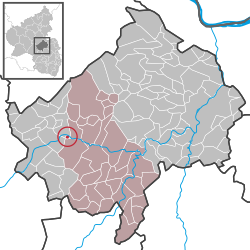Martinstein
| Martinstein | ||
|---|---|---|
|
||
| Coordinates: 49°48′14″N 7°32′28″E / 49.80389°N 7.54111°ECoordinates: 49°48′14″N 7°32′28″E / 49.80389°N 7.54111°E | ||
| Country | Germany | |
| State | Rhineland-Palatinate | |
| District | Bad Kreuznach | |
| Municipal assoc. | Bad Sobernheim | |
| Government | ||
| • Mayor | Paul-Walter Bock | |
| Area | ||
| • Total | 0.39 km2 (0.15 sq mi) | |
| Elevation | 190 m (620 ft) | |
| Population (2015-12-31) | ||
| • Total | 283 | |
| • Density | 730/km2 (1,900/sq mi) | |
| Time zone | CET/CEST (UTC+1/+2) | |
| Postal codes | 55627 | |
| Dialling codes | 06754 | |
| Vehicle registration | KH | |
Martinstein is an Ortsgemeinde – a municipality belonging to a Verbandsgemeinde, a kind of collective municipality – in the Bad Kreuznach district in Rhineland-Palatinate, Germany. It belongs to the Verbandsgemeinde of Bad Sobernheim, whose seat is in the like-named town. Martinstein is a state-recognized tourism resort, and with an area of 39 ha is Germany’s smallest municipality by land area.
Martinstein lies right on the River Nahe’s left bank. Looming to the north is the Hunsrück, and to the south the North Palatine Uplands.
Clockwise from the north, Martinstein’s neighbours are the municipalities of Simmertal, Weiler bei Monzingen and Merxheim, all of which likewise lie within the Bad Kreuznach district.
At a narrowing in the Nahe valley and an old river crossing, a small settlement arose in the High Middle Ages within the greater municipal area of Simmern unter Dhaun (nowadays called Simmertal). It was, however, 1518 before this village was given its own municipal area, now the smallest in Germany. In 1340, Archbishop Heinrich of Mainz built a small castle over the village in his feud with the Waldgrave of Dhaun. It was even granted town rights in 1342. Martinstein formed along with Seesbach and Weiler its own lordly domain, which in 1359 the Archbishop of Mainz pledged to the Knight of Grasewege (Sobernheim). For 1,800 Rhenish guilders, he was to expand the facilities. As early as 1347, the Counts of Sponheim had been the pledgeholders, and by 1389 it was the Knights of Merxheim, who in turn were followed by yet other lords. The village belonged in the Middle Ages to the Mainz cathedral provost’s archdeaconry and thereby also to the Glan Archipresbyterium. Martinstein was, however, assigned in 1560 to the rural chapter of Glan, as was Simmern (Simmertal). Although the Lutheran faith was introduced in 1550 by the then village lords, a new Catholic parish arose as early as 1660. About 1555, great parts of the village belonged to the Knights of Hunolstein and the Lords of Sickingen. In 1660, the House of Leyen and the House of Ebersberg, called Weyers-Leyen, were landholders. The pledgings ended in 1655 when Archbishop Johann Philipp of Mainz of the House of Schönborn redeemed them and transferred the lordly rights to his family. They then built a small palatial residence on the site of the old castle, which by now had fallen into disrepair. The residence itself then stood until 1780, when it in turn had to be torn down. In 1620, during the Thirty Years' War, the residence was taken by the Spaniards, whose general, Marquis Ambrogio Spinola (1569–1630), mentioned the house in his despatch and even had a drawing of it made. In 1716, the Margraves of Baden bought all the lordly rights held by the Knights of Schönborn, doing the same with the Ebersberg holdings in 1779 and assigning all to the Badish Amt of Naumburg. Nevertheless, the Revolutionary French swept all these lordships away once they had overrun the Rhineland, and they then imposed their own administrative system based on the French Revolutionary model. Martinstein was grouped into the Mairie (“Mayoralty”) of Monzingen, which subsequently remained in force as the Bürgermeisterei (also “Mayoralty”) of Monzingen once Napoleonic times were over and the village had passed under the terms of the Congress of Vienna to the Kingdom of Prussia. In 1850, the stone bridge across the River Nahe was built. About 1953, Bundesstraße 41, which led through the village, had to be widened, a job that led to the disappearance of several old houses, changing the village’s appearance utterly. Until 1966, parts of Martinstein’s built-up area lay within neighbouring Simmern unter Dhaun’s, Weiler’s or Merxheim’s limits. The municipal limits have since been adjusted to put the whole village under one municipal administration, rather than four separate ones. Nevertheless, Martinstein is still Germany’s smallest municipality by area. In the course of administrative restructuring in Rhineland-Palatinate, Martinstein was assigned in 1970 to the Verbandsgemeinde of Bad Sobernheim.
...
Wikipedia



